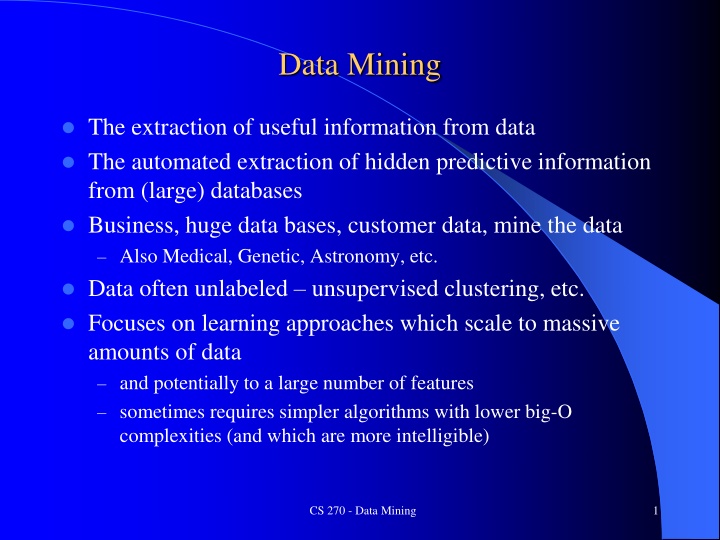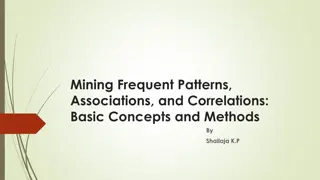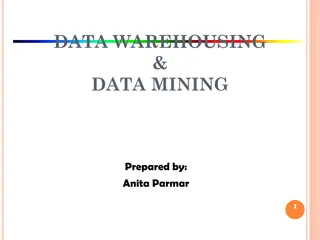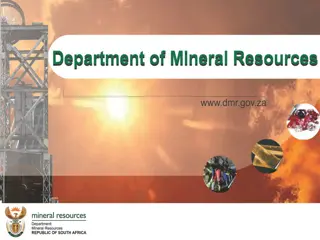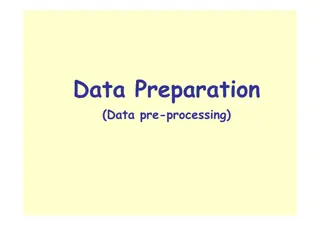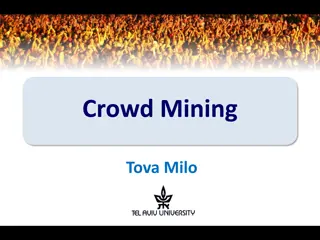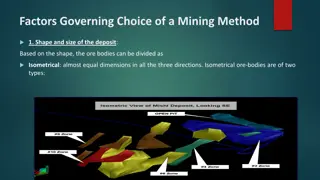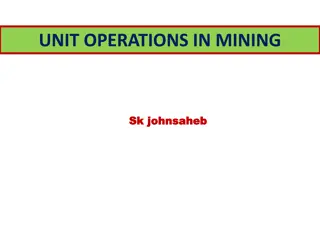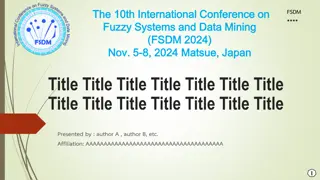Data Mining: Applications and Process
Learn about data mining, the extraction of valuable information from large datasets. Explore its applications in business decision-making, customer targeting, and information brokerage. Discover the data mining process model from task identification to model deployment for continual improvements.
Download Presentation

Please find below an Image/Link to download the presentation.
The content on the website is provided AS IS for your information and personal use only. It may not be sold, licensed, or shared on other websites without obtaining consent from the author.If you encounter any issues during the download, it is possible that the publisher has removed the file from their server.
You are allowed to download the files provided on this website for personal or commercial use, subject to the condition that they are used lawfully. All files are the property of their respective owners.
The content on the website is provided AS IS for your information and personal use only. It may not be sold, licensed, or shared on other websites without obtaining consent from the author.
E N D
Presentation Transcript
Data Mining The extraction of useful information from data The automated extraction of hidden predictive information from (large) databases Business, huge data bases, customer data, mine the data Also Medical, Genetic, Astronomy, etc. Data often unlabeled unsupervised clustering, etc. Focuses on learning approaches which scale to massive amounts of data and potentially to a large number of features sometimes requires simpler algorithms with lower big-O complexities (and which are more intelligible) CS 270 - Data Mining 1
Data Mining Applications Often seeks to give businesses a competitive advantage Which customers should they target For advertising more focused campaign Customers they most/least want to keep Most favorable business decisions Associations Which products should/should not be on the same shelf Which products should be advertised together Which products should be bundled Information Brokers Make transaction information available to others who are seeking advantages CS 270 - Data Mining 2
Data Mining Basically, a particular niche of machine learning applications Focused on business and other large data problems Focused on problems with huge amounts of data which needs to be manipulated in order to make effective inferences Mine for gems of actionable information CS 270 - Data Mining 3
Data Mining Popularity Recent Data Mining explosion based on: Data available Transactions recorded in data warehouses From these warehouses specific databases for the goal task can be created Algorithms available Machine Learning and Statistics Including special purpose Data Mining software products to make it easier for people to work through the entire data mining cycle Computing power available Competitiveness of modern business need an edge CS 270 - Data Mining 4
Data Mining Process Model You will use much of this process in your group project 1. Identify and define the task (e.g. business problem) 2. Gather and Prepare the Data Build Data Base for the task Select/Transform/Derive features Analyze and Clean the Data, remove outliers, etc. 3. Build and Evaluate the Model(s) Using training and test data 4. Deploy the Model(s) and Evaluate business related Results Data visualization tools 5. Iterate through this process to gain continual improvements both initially and during life of task Improve/adjust features and/or machine learning approach CS 270 - Data Mining 5
Data Mining Process Model - Cycle Monitor, Evaluate, and update deployment CS 270 - Data Mining 6
Data Science and Big Data Interdisciplinary field about scientific methods, processes and systems to extract knowledge or insights from data Machine Learning Statistics/Math CS/Database/Algorithms Visualization Parallel Processing Etc. Increasing demand in industry! Data Science Departments and Tracks New DS emphasis in BYU CS began Fall 2019 New ML degree in final stages of approval CS 270 - Data Mining 7
Group Projects Review timing and expectations Progress Report Time purposely available between Decision Tree and Instance Based projects to keep going on the group project Gathering, Cleaning, Transforming the Data can be the most critical part of the project, so get that going early!! Then plenty of time to try some different ML models and some iterations on your Features/ML approaches to get improvements Final report and presentation Questions? CS 270 - Data Mining 8
Association Analysis Link Analysis Used to discover relationships in large databases Relationships represented as association rules Unsupervised learning, any data set One example is market basket analysis which seeks to understand more about what items are bought together This can then lead to improved approaches for advertising, product placement, etc. Example Association Rule: {Cereal} {Milk} Transaction ID and Info 1 and (who, when, etc.) 2 3 4 5 Items Bought {Ice cream, milk, eggs, cereal} {Ice cream} {milk, cereal, sugar} {eggs, yogurt, sugar} {Ice cream, milk, cereal} CS 270 - Data Mining 9
Data Warehouses Companies have large data warehouses of transactions Records of sales at a store On-line shopping Credit card usage Phone calls made and received Visits and navigation of web sites, etc Many/Most things recorded these days and there is potential information that can be mined to gain business improvements For better customer service/support and/or profits CS 270 - Data Mining 10
Association Analysis Link Analysis Used to discover relationships in large databases Relationships represented as association rules Unsupervised learning, any data set One example is market basket analysis which seeks to understand more about what items are bought together This can then lead to improved approaches for advertising, product placement, etc. Example Association Rule: {Cereal} {Milk} Transaction ID and Info 1 and (who, when, etc.) 2 3 4 5 Items Bought {Ice cream, milk, eggs, cereal} {Ice cream} {milk, cereal, sugar} {eggs, yogurt, sugar} {Ice cream, milk, cereal} CS 270 - Data Mining 11
Association Discovery Association rules are not causal, show correlations k-itemset is a subset of the possible items {Milk, Eggs} is a 2-itemset Which itemsets does transaction 3 contain Association Analysis/Discovery seeks to find frequent itemsets TID Items Bought 1 {Ice cream, milk, eggs, cereal} 2 {Ice cream} 3 {milk, cereal, sugar} 4 {eggs, yogurt, sugar} 5 {Ice cream, milk, cereal} CS 270 - Data Mining 12
Association Rule Quality TID Items Bought 1 {Ice cream, milk, eggs, cereal} 2 {Ice cream} 3 {milk, cereal, sugar} 4 {eggs, yogurt, sugar} 5 {Ice cream, milk, cereal} t T, the set of all transactions, and X and Y are itemsets Rule quality measured by support and confidence Without sufficient support (frequency), rule will probably overfit, and also of little interest, since it is rare Note support(X=> Y) = support(Y => X) = support(X Y) Note that support(X Y) is support for itemsets where both Xand Y occur Confidence measures reliability of the inference (to what extent does X imply Y) confidence(X=> Y) != confidence(Y => X) Support and confidence range between 0 and 1 Lift: Lift is high when X=> Y has high confidence and the consequent Y is less common, Thus lift suggests ability for X to infer a less common value with good probability CS 270 - Data Mining 13
Association Rule Discovery Defined User supplies two thresholds minsup (Minimum required support level for a rule) minconf (Minimum required confidence level for a rule) Association Rule Discovery: Given a set of transactions T, find all rules having support minsupand confidence minconf How do you find the rules? Could simply try every possible rule and just keep those that pass Number of candidate rules is exponential in the size of the number of items Standard Approaches - Apriori 1st find frequent itemsets (Frequent itemset generation) Then return rules within those frequent itemsets that have sufficient confidence (Rule generation) Both steps have an exponential number of combinations to consider Number of itemsets exponential in number of items m (power set: 2m) Number of rules per itemset exponential in number of items in itemset (n!) CS 270 - Data Mining 14
Apriori Algorithm The support for the rule X Y is the same as the support of the itemset X Y Assume X = {milk, eggs} and Y = {cereal}. C = X Y All the possible rule combinations of itemset C have the same support (# of possible rules exponential in width of itemset: |C|!) {milk, eggs} {cereal} {milk} {cereal, eggs} {eggs} {milk, cereal} {milk, cereal} {eggs} {cereal, eggs} {milk} {cereal} {milk, eggs} Do they have the same confidence? So rather than find common rules we can first just find all itemsets with support minsup These are called frequent itemsets After that we can find which rules within the common itemsets have sufficient confidence to be kept CS 270 - Data Mining 15
Support-based Pruning Apriori Principle: If an itemset is frequent, then all subsets of that itemset will be frequent Note that subset refers to the items in the itemset If an itemset is not frequent, then any superset of that itemset will also not be frequent CS 270 - Data Mining 16
Example transaction DB with 5 items and 10 transactions Minsup = 30%, at least 3 transaction must contain the itemset For each itemset at the current level of the tree (depth k) go through each of the n transactions and update tree itemset counts accordingly All 1-itemsets are kept since all have support 30% CS 270 - Data Mining 17
Generate level 2 of the tree (all possible 2-itemsets) Normally use lexical ordering in itemsets to generate/count candidates more efficiently (a,b), (a,c), (a,d), (a,e), (b,c), (b,d), , (d,e) When looping through n transactions for (a,b), can stop if a not first in the set, etc. Number of tree nodes will grow exponentially if not pruned Which ones can we prune assuming minsup = .3? CS 270 - Data Mining 18
Generate level 2 of the tree (all possible 2-itemsets) Use lexical ordering in itemsets to generate/count candidates more efficiently (a,b), (a,c), (a,d), (a,e), (b,c), (b,d), , (d,e) When looping through n transactions for (a,b), can stop if a not first in the set, etc. Number of tree nodes will grow exponentially if not pruned Which ones can we prune assuming minsup = .3? CS 270 - Data Mining 19
Generate level 3 of the tree (all 3-itemsets with frequent parents) Before calculating the counts, check to see if any of these newly generated 3-itemsets, contain an infrequent 2-itemset. If so we can prune it before we count since it must be infrequent A k-itemset contains k subsets of size k-1 It's parent in the tree is only one of those subsets Are there any candidates we can delete? CS 270 - Data Mining 20
Frequent itemsets are: {a,c}, {a,c,d}, {a,c,e}, {a,d}, {a,d,e}, {a,e}, {b,c}, {c,d}, {c,e}, {d,e} CS 270 - Data Mining 25
Rule Generation Frequent itemsets were: {a,c}, {a,c,d}, {a,c,e}, {a,d}, {a,d,e}, {a,e}, {b,c}, {c,d}, {c,e}, {d,e} For each frequent itemset generate the possible rules and keep those with confidence minconf First itemset {a,c} gives possible rules {a} {c} with confidence 4/7 and {c} {a} with confidence 4/7 Second itemset {a,c,d} leads to six possible rules Just as with frequent itemset generation, we can use pruning and smart lexical ordering to make rule generation more efficient Project? Search pruning tricks (312) vs ML CS 270 - Data Mining 26
Illustrative Training Set Would if we had real valued data? What are steps for this example? Risk Assessment for Loan Applications Client # 1 2 3 4 5 6 7 8 9 10 11 12 13 14 Credit History Bad Unknown Unknown Unknown Unknown Unknown Bad Bad Good Good Good Good Good Bad Debt Level High High Low Low Low Low Low Low Low High High High High High Collateral None None None None None Adequate None Adequate None Adequate None None None None Income Level Low Medium Medium Low High High Low High High High Low Medium High Medium RISK LEVEL HIGH HIGH MODERATE HIGH LOW LOW HIGH MODERATE LOW LOW HIGH MODERATE LOW HIGH CS 270 - Data Mining 27
Running Apriori (I) Choose MinSupport = .4 and MinConfidence = .8 1-Itemsets (Level 1): (CH=Bad, .29) (CH=Unknown, .36) (CH=Good, .36) (DL=Low, .5) (DL=High, .5) (C=None, .79) (C=Adequate, .21) (IL=Low, .29) (IL=Medium, .29) (RL=High, .43) (RL=Moderate, .21) (RL=Low, .36) (IL=High, .43) CS 270 - Data Mining 28
Running Apriori (II) 1-Itemsets = {(DL=Low, .5); (DL=High, .5); (C=None, .79); (IL=High, .43); (RL=High, .43)} 2-Itemsets = {(DL=High + C=None, .43)} 3-Itemsets = {} Two possible rules: DL=High C=None C=None DL=High Confidences: Conf(DL=High C=None) = .86 Conf(C=None DL=High) = .54 Retain Ignore CS 270 - Data Mining 29
Summary Association Analysis useful in many real world tasks Not a classification approach, but a way to understand relationships in data and use this knowledge to advantage Also standard classification and other approaches Data Mining continues to grow as a field Data and features issues Gathering, Selection and Transformation, Preparation, Cleaning, Storing Data visualization and understanding Outlier detection and handling Time series prediction Web mining etc. CS 270 - Data Mining 30
Data Warehouse Companies have large data warehouses of transactions Records of sales at a store On-line shopping Credit card usage Phone calls made and received Visits and navigation of web sites, etc Many/Most things recorded these days and there is potential information that can be mined to gain business improvements For better customer service/support and/or profits Data Warehouse (DWH) Separate from the operational data (OLTP Online transaction processing) Data comes from heterogeneous company sources Contains static records of data which can be used and manipulated for analysis and business purposes Old data is rarely modified, and new data is continually added OLAP (Online Analytical Processing) Front end to DWH allowing basic data base style queries Useful for data analysis and data gathering and creating the task data base CS 270 - Data Mining 31
The Big Picture: DBs, DWH, OLAP & DM OLAP Server other sources Analysis, Query, Reports, Create Data Base for Data mining Operational DBs Extract Transform Load Refresh Data Warehouse Serve Data Storage OLAP Engine Front-End Tools CS 270 - Data Mining 32
